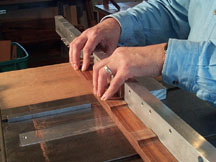Fretboard Design
The fretboard in Bear Meadow Appalachian dulcimers is the "raised fretboard" design. This is a truly evolutionary design.
- In conventional instruments the fretboard is hollow and shaped in an inverted "U". The ends of the legs of this inverted "U" are glued to the top, and the top is then carved out to open the fretboard to the interior cavity of the dulcimer body. In effect, the fretboard can be considered a vestigial Scheitholt attached to a sound-box.
- The raised fretboard is not hollow. Instead, it has "feet" which occur at various intervals along its length. Between the feet, material is removed so the fretboard looks like an arched bridge with many abutments running along the dulcimer. The fretboard is no longer a vestigial Scheitholt, and its acoustic relationship to the body is quite different:
- The area where the feet are attached to the top determine where the fretboard and top are constrained to move in the same mode. The placement of the feet thus are partly responsible for shaping the voice of the instrument.
- The top is much less constrained by the fretboard, and is not divided into two unrelated areas by the hollow under the fretboard. The instrument seems much louder.
- In the hollow fretboard , the outer strings vibrate over about 3/4" of solid wood, whereas the inner strings vibrate over 1/4" or less. Thus there will be subtle differences of timbre as you move from string to string. The raised fretboard avoids this effect.
Another matter in fretboard design is the "relief profile," or amount of concavity in the fretboard, as measured from nut to saddle. This is carefully calibrated in Bear Meadow instruments. Also carefully controlled is the amount of built-in tension between the fretboard and the top.

Click to see full size
